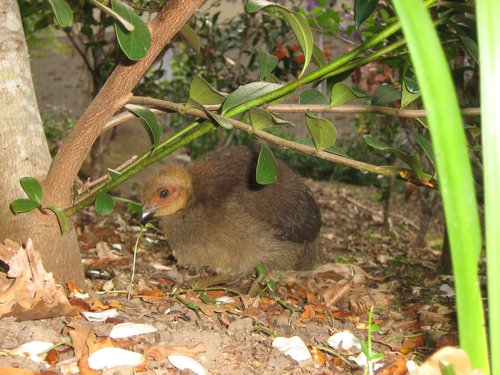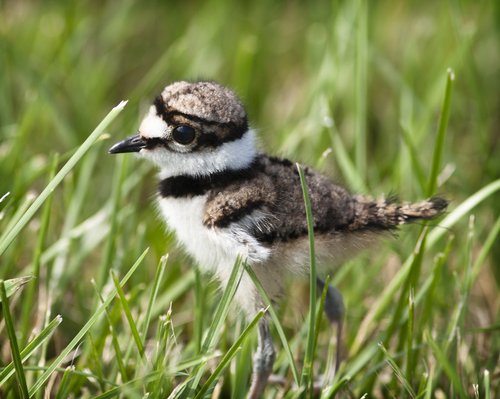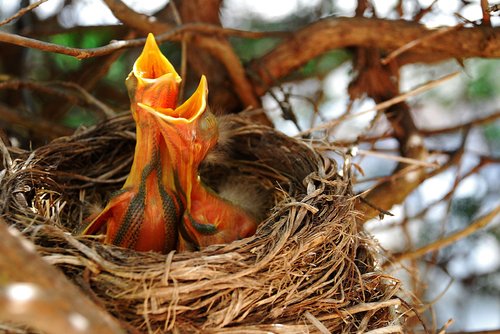Hanover Bald Eagle Blog # 19
In partnership with Pennsylvania Game Commission and Comcast Business .
Liberty and Freedom sure stick to the bald eagle schedule! True to our expectations, the chicks hatched two days apart, mirroring their laying interval. This week, many of us have likely been sneaking peaks at the Hanover nest every chance we get, soaking up what can objectively be described as adorable offspring.
The first-born hatchling is about a week old, and already growth is apparent. This fast-paced development is typical of young birds, but especially for “semi-altricial” young, as bald eagles are called. As a reminder, there are two main types of development in baby birds: Altricial, a word coming from the Latin root “to nourish,” refers to hatchlings that are virtually unable to care for themselves at birth. They must be fed by their parents, their mobility is limited, adults assist in keeping them warm, and they are unable to fly. On the opposite end of the spectrum are precocial young, coming from the same Latin root as “precocious.” These hatchlings are born with their eyes open, require little assistance in feeding, can walk or swim soon after hatching, and are able to thermoregulate. Extreme examples of precocial young are found in species such as the Brush Turkey for which hatchling independence takes on a whole new meaning: these birds lay their eggs in piles of decaying plant matter, and the hatchlings are born alone and dig themselves out, feathered and able to fly once they emerge above ground.

Brush Turkey Hatchling. Photo credit: Wikipedia Commons

Precocial Killdeer. Photo Credit: George Thomas, 2010
Bald eagles sit in the middle of these two strategies, hence the name semi-altricial; they are born with open eyes and downy feathers, yet they are immobile and dependent on parents for food. Semi-altricial is a common development pattern for raptors.
Researchers have mused over what would cause birds to be born with such varying degrees of helplessness, and often the discussion returns to the idea of tradeoffs. Caring for altricial young requires parents to invest significantly more energy during the post-hatching period, while precocial young require parents to create an energetically rich and nutritious egg yolk, but lets them off the hook during the post-hatching time period, as they do not need attend to their hatchlings for long.
The difference between these two modes of parental investment are related to environmental pressures. The strategy of having precocial young is thought to have evolved first, with species having altricial young evolving more recently. Nowadays however, more than 80% of birds have altricial young, implying that the strategy has evolved to be a better fit for the majority of species.
The strategy of raising altricial young has been called the “individual care” strategy, while precocial has been deemed “mass production” strategy. This is because species that raise altricial young typically have smaller clutch sizes, likely related to the risk of predation: parents with altricial young spend a lot of energy making sure nobody gets eaten, by protecting them within a nest while they develop so even though fewer eggs are laid, each individual has a higher likelihood of surviving. Precocial chicks on the other hand are vulnerable for a longer period of time since they leave the nest right away, and therefore laying more eggs may act as insurance against the fact that some hatchlings likely won’t make it.
Another environmental pressure to consider is food availability. For many species, there is a strong correlation between timing of food availability and reproductive strategy. For example, raising precocial young is a common strategy for species that eat plants (such as ducks and geese), because plant availability is more constant than then say, mice or insect availability.
Bald eagles, being scavengers, may have few constraints when it comes to finding food. Ice and snow are the primary limiting factors on their ability to forage, but most eagles have strategies to compensate for these seasonal factors, such as short-distance migrations, or finding alternative food sources like butcher scraps, or even dumps. Additionally, bald eagles do not need to worry about many predators, so their semi-altricial strategy make a lot of sense for the way they operate within the world!
In the coming weeks of development keep an eye out for rapid growth and increased locomotion in the hatchlings. Already Liberty and Freedom have switched from regurgitating liquid food into the hatchling’s mouths (witnessed on their first day of hatch), to providing them with small pieces of solid food. Oh, how time flies when they’re young!
FUN FACT: CUTENESS
Some researchers have proposed that the apparent helplessness of altricial young cues a caretaking response that ensures they will be cared for appropriately until they are ready to leave the nest. While it does not seem likely that parents would simply abandon the nest if their hatchlings weren’t cute enough, it may be reasonable to expect that the helplessness and correspondingly endearing traits of altricial young do serve some purpose. Researchers have also noted that some baby birds are so extremely altricial that they are not cute, such as robins, and therefore there must be some other “evolutionary mechanism” in place that we do not yet understand.

Robin chicks. Photo Credit: Benny Lin

RETURN TO HANOVER BALD EAGLE BLOGS
WATCH THE HANOVER BALD EAGLE LIVE CAMS
For over 20 years, HDOnTap has provided live streaming solutions to resorts, amusement parks, wildlife refuges and more. In addition to maintaining a network of over 400 live webcams, HDOnTap specializes in design and installation of remote, off-grid and otherwise challenging live streaming solutions. Contact press@hdontap.com for all media needs, including images and recordings.